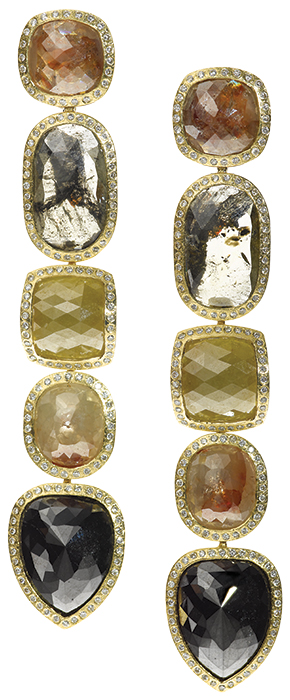|
Cover
American Pride
With offerings from every state, Gallery Fifty in Traverse City, Michigan, celebrates American creativity and craftsmanship.
By Joyce Kauf

|
| Todd Reed |
For years, American craft has been given a bad rap. My goal is to redefine and promote creative and innovative American craftsmanship on the same level as fine art,” explains Christie Minervini, owner of Gallery Fifty in Traverse City, Michigan. Reflecting her passion for a “true American craft gallery representing artists from all 50 states,” the store features jewelry, art, ceramics and gifts ranging from “fun and funky to modern and refined.”
“Crafts used to call to mind items that were sold at church bazaars,” says Minervini, emphasizing the distinction of the “highly crafted, highly original and high-quality” products that she sources from 150 regional and North American artists. Minervini, who has a background in graphic arts and advertising, admits that she contemplated opening a gallery for more than a decade. Over the course of that time, Minervini would identify artists that she wanted to represent. “I realized they were from all over the country. ‘Wouldn’t it be cool to show a visitor an artist from her home state?’’’ she thought.
“It was very fortuitous the way it finally came to be,” says Minervini. At the same time she decided to “take the leap” in 2004, The Village at the Grand Traverse Commons was being redeveloped for retail. The site — coincidentally called “Building 50” — had been an insane asylum in the nineteenth century, known as Traverse City State Hospital. Traverse City, located on the Lower Michigan Peninsula, is now primarily a resort community that attracts people from Chicago and Detroit for its “gorgeous” natural setting and cultural events.
“With its historic architecture, Building 50 was an ideal location for showcasing fine arts and crafts,” Minervini points out. One of two original tenants, she credits the overflow from the other tenant, an Italian restaurant, with helping to grow her business. Minervini began with four cases in a 12-foot-wide hallway, which she describes as “my little bowling alley.” In 2007, she expanded to 1,800 square feet in the Mercato — Italian for marketplace — an indoor shopping and dining venue of over 60 businesses within Building 50.
While Minervini does not strive to be “everything to everyone,” she offers a wide array of price points with items that range from painted rocks with amusing sayings that sell for under $5 to fine jewelry that retails for $6,500. Tourists account for approximately 70 percent of her sales. But business people also favor gifts from local artists that they can give to clients both here and abroad. For her customers who want to take home “a piece of Michigan,” Minervini carries items made from the honeycomb-patterned Petoskey stone, the state’s official stone, that was derived from the coral formed millions of years ago under Lake Michigan.
Jewelry accounts for about 50 percent to 60 percent of Gallery Fifty’s business, with designer jewelry contributing about 20 percent of that total. Minervini represents 45 jewelry artists and cites Todd Reed and Anne Sportun as her top designers. Also popular are the sterling and semiprecious jewelry from Nina Mann, a local Traverse City designer, and Sydney Lynch from Nebraska. Careful to avoid any duplication, her criteria for selecting a new designer include design, materials and price point, but the “fiercely protective” Minervini will not jeopardize an existing strong relationship.
“My customers embrace the idea of the nontraditional. It doesn’t have to include the 4Cs,” Minervini explains, adding that they favor colored diamonds, black diamonds and raw diamonds. Another trend among the younger demographic is the “one-ring aesthetic,” where the engagement ring is also the wedding band.
Colored gemstones and semiprecious stones, such as chalcedony, also sell well, especially in shades of blues and greens, reflecting the color of the water that surrounds this vacation spot.
The building retains the original foundation and blond-colored bricks of the former asylum. A new red-painted russet floor extends throughout the entire Mercato. Minervini uses a combination of wood and metal cases to display her products, with 16 cases devoted to jewelry. Adhering to the belief that customers are more likely to buy an item they can touch, jewelry and other items are displayed on top of the counter as well. Throughout the gallery, the artists and their location are identified.
“My goal was to make everything approachable. I wanted to erase the mystique and pretension around fine-crafted jewelry and introduce people to these unique items in an intimate surrounding,” says Minervini. With a retail philosophy that revolves around craftsmanship, she takes her responsibility of educating the customer very seriously. “I will go out of my way to give them the idea of why something is valuable and valued,” she explains. “I want them to recognize the original creativity that sparked the idea for a piece crafted over several days — unlike 1,000 mass-produced pieces made in one day.”
Given her background in design, Minervini’s number one merchandising consideration is color. The gallery consists of four rooms, which allows her to create four distinct environments. “One might be very bright with a lot of glass, another more modern and contemporary, one traditional and still another could be woody and rustic,” she notes. “I don’t believe in perfect displays,” says Minervini, who might turn an item in the opposite direction to give the impression it was touched or tried on.
“Quality, originality and the artist’s creativity are to be appreciated and recognized,” concludes Minervini. “It may be a romantic notion, but I steadfastly believe in American craftsmanship.”Article from the Rapaport Magazine - July 2015. To subscribe click here.
|
|